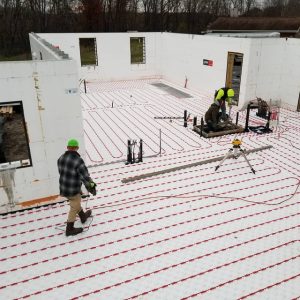If you’re thinking about heating your garage or workshop, radiant floor heating can be an efficient and practical option.
With its ability to provide consistent warmth from the ground up, it’s an appealing alternative to traditional forced-air systems. However, as with any heating system, it comes with its pros and cons. Let’s break them down.
The Pros
Concrete Slabs Are Ready for It
Most garages and workshops already have concrete slabs for durability, making them perfect candidates for radiant heating. Installing a system beneath the slab takes advantage of the natural thermal mass, allowing for long-lasting warmth.
Even Temperatures Where It Matters
One of the best parts of radiant heating is the even distribution of heat. You’ll notice the most warmth at your feet, where you need it, while the ceiling stays cooler—no wasted energy heating areas where you’re not.
Energy Efficiency
Radiant heating is known for its energy efficiency, especially once the concrete slab reaches its target temperature. It requires minimal energy to maintain that warmth, provided you have proper insulation. In fact, good insulation—both under the slab and throughout the structure—is key to maximizing efficiency.
Comfort Boost
For those who spend long hours in their workshop or garage, warm floors can make a big difference in comfort. If warmer feet lead to increased productivity, radiant heat is a win for you.

No Cold Surfaces
Another benefit of radiant heat is that it prevents that uncomfortable feeling of picking up cold tools or touching icy surfaces. Everything stays warm to the touch.
No Fans, No Noise, No Dust
Radiant heating systems operate quietly without blowing air. This means no noisy fans and a lot less dust circulating in your workspace. Plus, with no vents or grilles in the way, you’ll enjoy more open space and easier cleaning.
Quick-Drying Floors
Radiant heat helps floors dry faster, which is especially useful if you’re working in a space where moisture or spills are common.
Expand to Snow Melting
One added perk: you can extend your radiant heating system to the vehicle apron outside your garage. Running the system on a separate zone can help keep snow and ice from accumulating near your entrance, making winter days a bit easier.
The Cons
Slow to Adjust
One downside to radiant floor heating is that it takes time to heat up or cool down. This makes it less ideal for situations where you want rapid temperature changes.
Best for Continuous Use
Radiant heating works best when it’s run continuously. If you’re frequently turning it on and off, you might find the slow response time frustrating.
Not a Cooling Solution
It’s important to note that radiant floor heating is just that—heating. It won’t double as an air conditioning system like a heat pump can. If you need cooling during the warmer months, you’ll need a separate solution.

Our blog series Streamlining Radiant Heating Installation with Heat-Sheet Heavy: A Professional’s Guide offers a practical insight into utilizing Heat-Sheet Heavy for optimal radiant heating installation, drawing from a real-world application that was documented in detail in this excellent video from Kyle Stumpenhorst of RR Buildings.






